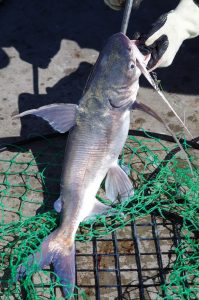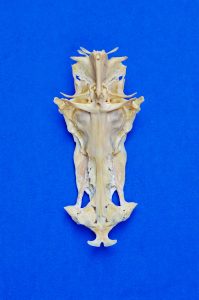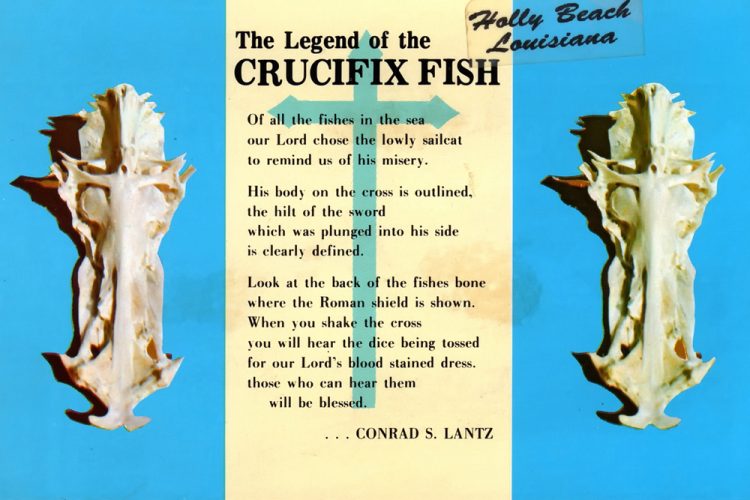This original 1960s postcard, sold along the Gulf Coast, featured Conrad Lantz’s poem, The Legend of the Crucifix Fish, with photos showing the unusual bones from a sailcat.
Page From the Past: Conrad Lantz & The Legend of the Crucifix Fish
By Keith “Catfish” Sutton

Of all the fishes in the sea
our Lord chose the lowly sailcat
to remind us of his misery.
His body on the cross is outlined.
The hilt of the sword
that was plunged into his side
is clearly defined.
Look at the back of the fish’s bone.
The Roman shield is shown.
When you shake the cross
you will hear the dice being tossed
for our Lord’s blood-stained dress.
Those who can hear them will be blessed
On docks and roadside souvenir stands along the Gulf Coast in the 1960s, a peculiar curiosity caught the attention of passing anglers and tourists alike: the dried bone of a saltwater sailcat, neatly packaged in a small box, accompanied by a short poem and a message of faith. Known popularly as “The Crucifix Fish,” this unusual item merged regional folklore, religious symbolism and marine biology into one haunting relic of the sea.
At the heart of this novelty was a brief poem titled “The Legend of the Crucifix Fish,” attributed to a man named Conrad S. Lantz—the same poem reproduced at the beginning of this article. While little is known about Lantz himself, the poem became the voice of a uniquely Southern legend. It told how God chose the humble sailcat to carry a message of Jesus’ suffering, with imagery describing the bones as symbols of the crucifixion: a cross, a sword’s hilt, a Roman shield and even dice rattling for Christ’s robe.

This poem appeared on postcards distributed in the early 1960s, often bearing the name of the Gulfport Marine Museum or other regional attractions. The cards included printed illustrations or photographs of the fish bone and poetic lines connecting the anatomy of the sailcat skeleton to elements of the Passion of Christ.
Collectors and travelers could also purchase a souvenir kit, typically sold in coastal gift shops. These small boxes contained a dried sailcat bone—cleaned and whitened to highlight the cruciform shape—alongside the Lantz poem and, in some cases, a postcard or brief write-up of the legend. Over time, these boxed sets became part folk art, part religious keepsake.
The sailcat, or gafftopsail catfish (Bagre marinus), is a common catch in the Gulf of Mexico. When the fish’s flesh is removed or rots away, the bony structure on the underside of its skull can be seen.
The raised portion of the skull’s interior has the distinct shape of a cross or crucifix. When you hold this upright so the cross is visible in its proper position, there is a bone at the very bottom said to resemble the hilt of an upward-pointing sword that was thrust through Jesus’ side after he was dead. One can also see an outline of the impaled blade and the tip of the sword pointing to the heart that it pierced.
On the upper (outer) side of the skull, some viewers perceive the Roman soldier’s shield. The poem’s reference to dice being rolled comes from otoliths, small calcified “ear stones” in the skull. When the bone is shaken, they rattle, echoing the Roman soldiers casting dice for Christ’s garments.
Whether these things are viewed as coincidence, divine messages or marketing creativity, the imagery stuck.
Lantz’s poem, while not widely published beyond these postcards and souvenirs, was effective in anchoring the legend in the minds of many. The language is simple, direct and reverent, speaking to a generation raised on Sunday school stories and salt air.
Today, you can still find the so-called “Crucifix Fish” sold online through vintage dealers or displayed in beach-town antique shops. While we may never know much more about Conrad S. Lantz, his words and the curious bones of a common Gulf fish continue to provoke wonder, reflection and a uniquely Southern sense of reverence.



